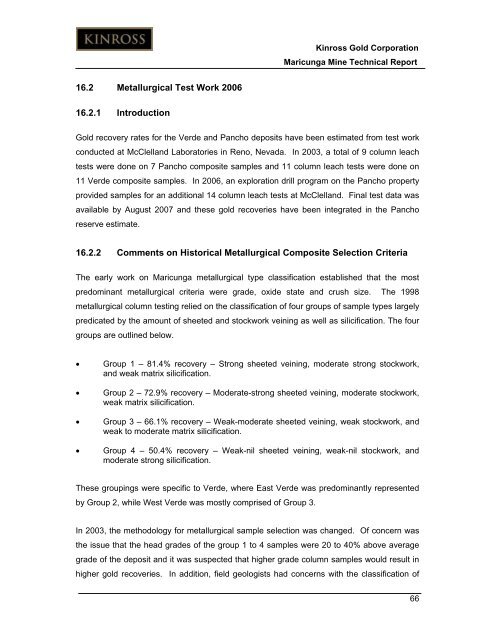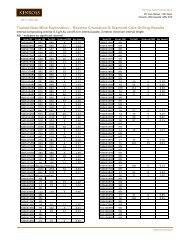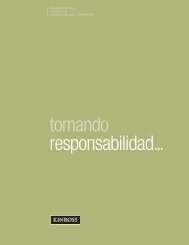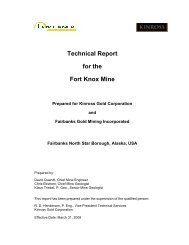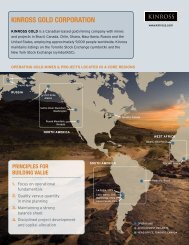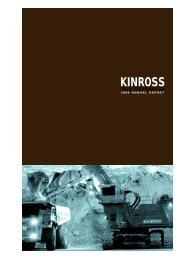Technical Report for the Maricunga Gold Mine - Kinross Gold
Technical Report for the Maricunga Gold Mine - Kinross Gold
Technical Report for the Maricunga Gold Mine - Kinross Gold
- No tags were found...
Create successful ePaper yourself
Turn your PDF publications into a flip-book with our unique Google optimized e-Paper software.
<strong>Kinross</strong> <strong>Gold</strong> Corporation<strong>Maricunga</strong> <strong>Mine</strong> <strong>Technical</strong> <strong>Report</strong>16.2 Metallurgical Test Work 200616.2.1 Introduction<strong>Gold</strong> recovery rates <strong>for</strong> <strong>the</strong> Verde and Pancho deposits have been estimated from test workconducted at McClelland Laboratories in Reno, Nevada. In 2003, a total of 9 column leachtests were done on 7 Pancho composite samples and 11 column leach tests were done on11 Verde composite samples. In 2006, an exploration drill program on <strong>the</strong> Pancho propertyprovided samples <strong>for</strong> an additional 14 column leach tests at McClelland. Final test data wasavailable by August 2007 and <strong>the</strong>se gold recoveries have been integrated in <strong>the</strong> Panchoreserve estimate.16.2.2 Comments on Historical Metallurgical Composite Selection CriteriaThe early work on <strong>Maricunga</strong> metallurgical type classification established that <strong>the</strong> mostpredominant metallurgical criteria were grade, oxide state and crush size. The 1998metallurgical column testing relied on <strong>the</strong> classification of four groups of sample types largelypredicated by <strong>the</strong> amount of sheeted and stockwork veining as well as silicification. The fourgroups are outlined below.• Group 1 – 81.4% recovery – Strong sheeted veining, moderate strong stockwork,and weak matrix silicification.• Group 2 – 72.9% recovery – Moderate-strong sheeted veining, moderate stockwork,weak matrix silicification.• Group 3 – 66.1% recovery – Weak-moderate sheeted veining, weak stockwork, andweak to moderate matrix silicification.• Group 4 – 50.4% recovery – Weak-nil sheeted veining, weak-nil stockwork, andmoderate strong silicification.These groupings were specific to Verde, where East Verde was predominantly representedby Group 2, while West Verde was mostly comprised of Group 3.In 2003, <strong>the</strong> methodology <strong>for</strong> metallurgical sample selection was changed. Of concern was<strong>the</strong> issue that <strong>the</strong> head grades of <strong>the</strong> group 1 to 4 samples were 20 to 40% above averagegrade of <strong>the</strong> deposit and it was suspected that higher grade column samples would result inhigher gold recoveries. In addition, field geologists had concerns with <strong>the</strong> classification of66


